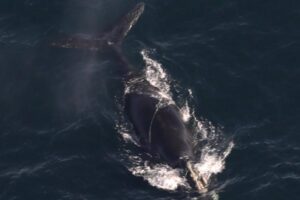 HYANNIS – Whale researchers at the Northeast Fisheries Science Center are observing large numbers of North Atlantic right whales and other whale species in Northeast waters.
HYANNIS – Whale researchers at the Northeast Fisheries Science Center are observing large numbers of North Atlantic right whales and other whale species in Northeast waters.
An aerial team flying for the Center out of the U.S. Coast Guard Air Station at Joint Base Cape Cod and from Hyannis, are continuing their long-term survey for right whales.
The effort supports a range of research and is part of an annual seasonal distribution and abundance survey of protected marine animals along the East Coast.
Researchers began seeing right whales in the region in mid-November.
As many as 158 individuals have been sighted on a single flight, often in aggregations of four or more.
“A very small portion of the right whale population heads south to the waters off northern Florida and Georgia in the winter, mostly just the moms to give birth,“ said Tim Cole, a marine mammal researcher and lead of the Center’s aerial whale survey team.
“We try to determine where the rest of the population is and have found them so far this year in large numbers on Nantucket Shoals and in Cape Cod Bay.”
The Northeast Fisheries Science Center, New England Aquarium, and the Center for Coastal Studies jointly monitor the waters off New England for right whales.
The whales tend to follow their food and are moving to different locations around the region as the season progresses.
Recently, NEFSC scientists on the Center’s research vessel Selkie sighted the first right whale mother and calf pair of the season in Cape Cod Bay.
That team is photographing whales and collecting small skin samples of whales not sampled before for population genetic studies, and was able to get a skin sample from the calf.
Last month, two more mother and calf pairs were sighted in Cape Cod Bay by the Center for Coastal Studies.
NEFSC researchers are also extending the aerial abundance survey into waters from Halifax, Nova Scotia to New Jersey, and sighting a number of species.
That survey is part of the Atlantic Marine Assessment Program for Protected Species (AMAPPS) funded by NOAA, the Bureau of Ocean Energy Management (BOEM), and the U.S. Navy.
The goal of the AMAPPS surveys is to estimate seasonal distribution patterns and abundance of as many species of cetaceans (whales, dolphins and porpoises), sea turtles, and seals as possible.
























